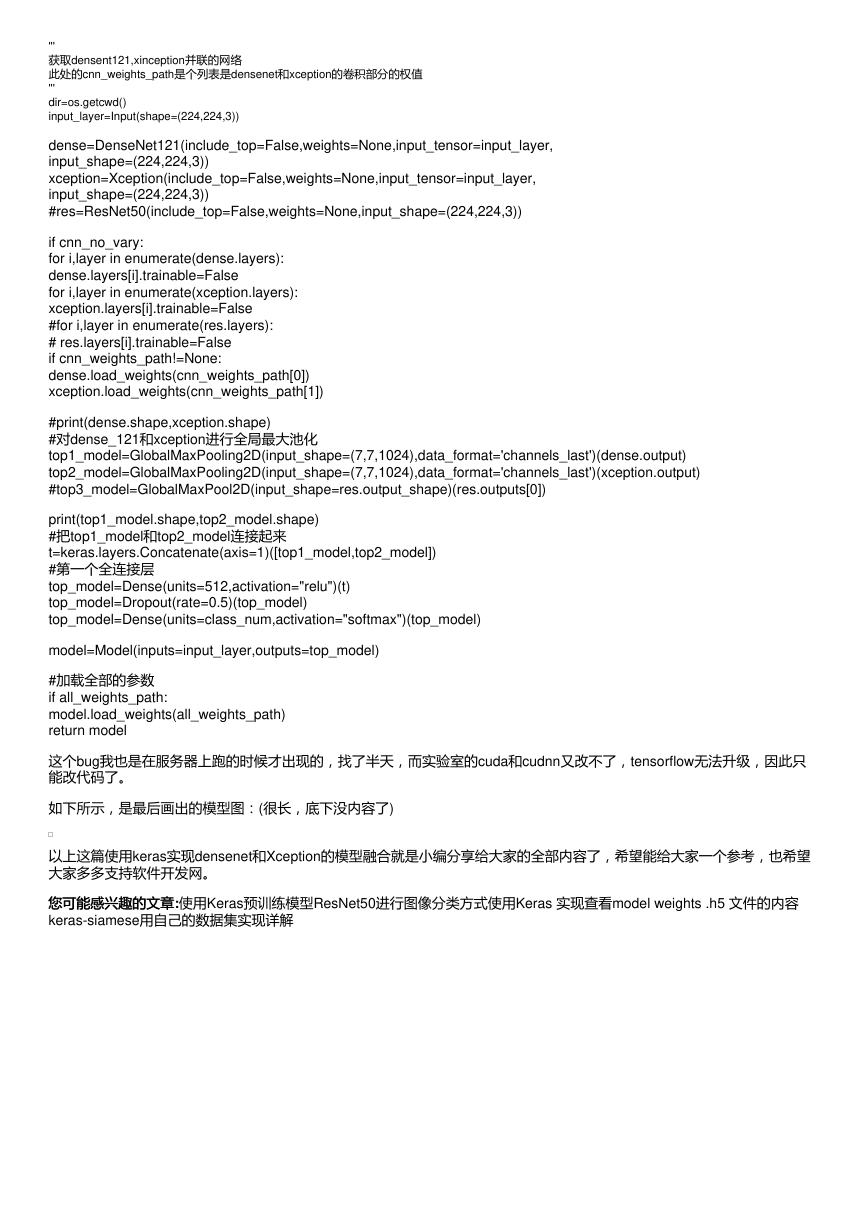使用使用keras实现实现densenet和和Xception的模型融合
的模型融合
我正在参加天池上的一个竞赛,刚开始用的是DenseNet121但是效果没有达到预期,因此开始尝试使用模型融合,将Desenet
和Xception融合起来共同提取特征。
代码如下:
def Multimodel(cnn_weights_path=None,all_weights_path=None,class_num=5,cnn_no_vary=False):
'''
获取densent121,xinception并联的网络
此处的cnn_weights_path是个列表是densenet和xception的卷积部分的权值
'''
input_layer=Input(shape=(224,224,3))
dense=DenseNet121(include_top=False,weights=None,input_shape=(224,224,3))
xception=Xception(include_top=False,weights=None,input_shape=(224,224,3))
#res=ResNet50(include_top=False,weights=None,input_shape=(224,224,3))
if cnn_no_vary:
for i,layer in enumerate(dense.layers):
dense.layers[i].trainable=False
for i,layer in enumerate(xception.layers):
xception.layers[i].trainable=False
#for i,layer in enumerate(res.layers):
# res.layers[i].trainable=False
if cnn_weights_path!=None:
dense.load_weights(cnn_weights_path[0])
xception.load_weights(cnn_weights_path[1])
#res.load_weights(cnn_weights_path[2])
dense=dense(input_layer)
xception=xception(input_layer)
#对dense_121和xception进行全局最大池化
top1_model=GlobalMaxPooling2D(data_format='channels_last')(dense)
top2_model=GlobalMaxPooling2D(data_format='channels_last')(xception)
#top3_model=GlobalMaxPool2D(input_shape=res.output_shape)(res.outputs[0])
print(top1_model.shape,top2_model.shape)
#把top1_model和top2_model连接起来
t=keras.layers.Concatenate(axis=1)([top1_model,top2_model])
#第一个全连接层
top_model=Dense(units=512,activation="relu")(t)
top_model=Dropout(rate=0.5)(top_model)
top_model=Dense(units=class_num,activation="softmax")(top_model)
model=Model(inputs=input_layer,outputs=top_model)
#加载全部的参数
if all_weights_path:
model.load_weights(all_weights_path)
return model
如下进行调用:
if __name__=="__main__":
weights_path=["./densenet121_weights_tf_dim_ordering_tf_kernels_notop.h5",
"xception_weights_tf_dim_ordering_tf_kernels_notop.h5"] model=Multimodel(cnn_weights_path=weights_path,class_num=6)
plot_model(model,to_file="G:/model.png")
最后生成的模型图如下:有点长,可以不看
需要注意的一点是,如果dense=dense(input_layer)这里报错的话,说明你用的是tensorflow1.4以下的版本,解决的方法就是
1、升级tensorflow到1.4以上
2、改代码:
def Multimodel(cnn_weights_path=None,all_weights_path=None,class_num=5,cnn_no_vary=False):
�
'''
获取densent121,xinception并联的网络
此处的cnn_weights_path是个列表是densenet和xception的卷积部分的权值
'''
dir=os.getcwd()
input_layer=Input(shape=(224,224,3))
dense=DenseNet121(include_top=False,weights=None,input_tensor=input_layer,
input_shape=(224,224,3))
xception=Xception(include_top=False,weights=None,input_tensor=input_layer,
input_shape=(224,224,3))
#res=ResNet50(include_top=False,weights=None,input_shape=(224,224,3))
if cnn_no_vary:
for i,layer in enumerate(dense.layers):
dense.layers[i].trainable=False
for i,layer in enumerate(xception.layers):
xception.layers[i].trainable=False
#for i,layer in enumerate(res.layers):
# res.layers[i].trainable=False
if cnn_weights_path!=None:
dense.load_weights(cnn_weights_path[0])
xception.load_weights(cnn_weights_path[1])
#print(dense.shape,xception.shape)
#对dense_121和xception进行全局最大池化
top1_model=GlobalMaxPooling2D(input_shape=(7,7,1024),data_format='channels_last')(dense.output)
top2_model=GlobalMaxPooling2D(input_shape=(7,7,1024),data_format='channels_last')(xception.output)
#top3_model=GlobalMaxPool2D(input_shape=res.output_shape)(res.outputs[0])
print(top1_model.shape,top2_model.shape)
#把top1_model和top2_model连接起来
t=keras.layers.Concatenate(axis=1)([top1_model,top2_model])
#第一个全连接层
top_model=Dense(units=512,activation="relu")(t)
top_model=Dropout(rate=0.5)(top_model)
top_model=Dense(units=class_num,activation="softmax")(top_model)
model=Model(inputs=input_layer,outputs=top_model)
#加载全部的参数
if all_weights_path:
model.load_weights(all_weights_path)
return model
这个bug我也是在服务器上跑的时候才出现的,找了半天,而实验室的cuda和cudnn又改不了,tensorflow无法升级,因此只
能改代码了。
如下所示,是最后画出的模型图:(很长,底下没内容了)
以上这篇使用keras实现densenet和Xception的模型融合就是小编分享给大家的全部内容了,希望能给大家一个参考,也希望
大家多多支持软件开发网。
您可能感兴趣的文章:使用Keras预训练模型ResNet50进行图像分类方式使用Keras 实现查看model weights .h5 文件的内容
您可能感兴趣的文章
keras-siamese用自己的数据集实现详解
�




 2023年江西萍乡中考道德与法治真题及答案.doc
2023年江西萍乡中考道德与法治真题及答案.doc 2012年重庆南川中考生物真题及答案.doc
2012年重庆南川中考生物真题及答案.doc 2013年江西师范大学地理学综合及文艺理论基础考研真题.doc
2013年江西师范大学地理学综合及文艺理论基础考研真题.doc 2020年四川甘孜小升初语文真题及答案I卷.doc
2020年四川甘孜小升初语文真题及答案I卷.doc 2020年注册岩土工程师专业基础考试真题及答案.doc
2020年注册岩土工程师专业基础考试真题及答案.doc 2023-2024学年福建省厦门市九年级上学期数学月考试题及答案.doc
2023-2024学年福建省厦门市九年级上学期数学月考试题及答案.doc 2021-2022学年辽宁省沈阳市大东区九年级上学期语文期末试题及答案.doc
2021-2022学年辽宁省沈阳市大东区九年级上学期语文期末试题及答案.doc 2022-2023学年北京东城区初三第一学期物理期末试卷及答案.doc
2022-2023学年北京东城区初三第一学期物理期末试卷及答案.doc 2018上半年江西教师资格初中地理学科知识与教学能力真题及答案.doc
2018上半年江西教师资格初中地理学科知识与教学能力真题及答案.doc 2012年河北国家公务员申论考试真题及答案-省级.doc
2012年河北国家公务员申论考试真题及答案-省级.doc 2020-2021学年江苏省扬州市江都区邵樊片九年级上学期数学第一次质量检测试题及答案.doc
2020-2021学年江苏省扬州市江都区邵樊片九年级上学期数学第一次质量检测试题及答案.doc 2022下半年黑龙江教师资格证中学综合素质真题及答案.doc
2022下半年黑龙江教师资格证中学综合素质真题及答案.doc